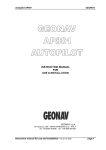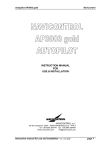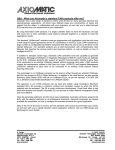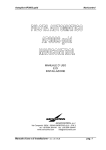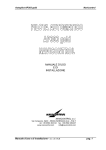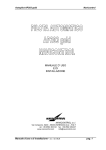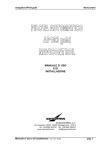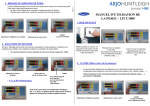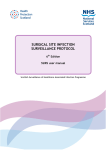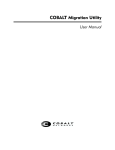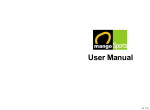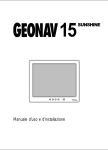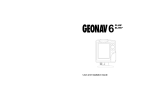Download INSTRUCTION MANUAL FOR USE & INSTALLATION
Transcript
Autopilot AP401 GEONAV INSTRUCTION MANUAL FOR USE & INSTALLATION GEONAV s.p.a. Via Vespucci, 289 - 55049 VIAREGGIO (LU) - ITALY tel. +39 0584 961696 fax. +39 0584 961309 Instruction manual for use and installation - rel. G1.14 / 04.05 page 1 Autopilot AP401 Instruction manual for use and installation - rel. G1.14 / 04.05 GEONAV page 2 Autopilot AP401 GEONAV Contents FOREWORD .......................................................................................................... 5 THE AP401 AUTOPILOT ....................................................................................... 6 USER’S MANUAL .................................................................................................... 7 IMPORTANT WARNINGS...................................................................................... 8 PRELIMINARY OPERATIONS AND START OF NAVIGATION. ........................... 9 Starting ................................................................................................................ 9 Display and keyboard illumination ....................................................................... 9 Setting of the operating parameters .................................................................... 9 Setting of the route and automatic navigation ................................................... 10 SIGNALED ALARMS .................................................................................................. 13 INSTALLATION MANUAL...................................................................................... 15 INSTALLATION PROCEDURES.......................................................................... 16 Control Unit ....................................................................................................... 16 Control Unit (as OPTIONAL remote control) ..................................................... 16 Processor Box ................................................................................................... 17 Fluxgate Compass FGX90/3, FGX90N ............................................................. 17 Rudder Angle Transducer FB30, FB31 ............................................................. 17 Electrohydraulic Unit.......................................................................................... 18 PRELIMINARY TEST. .......................................................................................... 19 Rudder Feedback FB30, FB31.......................................................................... 19 Rudder Indicator AR32, AR33, AR34 ................................................................ 19 Fluxgate Compass FGX90/3, FGX90N ............................................................. 19 Electrohydraulic Unit.......................................................................................... 19 GPS and/or Chart-Plotter .................................................................................. 19 Wind Direction Sensor....................................................................................... 20 Automatic compensation of the compass FGX90/3, FGX90N........................... 20 SOFTWARE INSTALLATION PROCEDURE....................................................... 22 TECHNICAL SPECIFICATION ............................................................................... 24 Instruction manual for use and installation - rel. G1.14 / 04.05 page 3 Autopilot AP401 Instruction manual for use and installation - rel. G1.14 / 04.05 GEONAV page 4 Autopilot AP401 GEONAV FOREWORD Thank you for purchasing a GEONAV product and congratulations for your excellent choice. You have now become the owner of a powerful and versatile electronic instrument which will make your moments of relax or work, at sea, more pleasant and secure. You will be pleasantly surprised when you realize how easy and logical this system is to use, though technologically sophisticated. No particular technical or nautical know-how is required for its correct use, nevertheless reading this manual with some attention will allow you to quickly learn and become confident in using it at it's best. Instruction manual for use and installation - rel. G1.14 / 04.05 page 5 Autopilot AP401 GEONAV THE AP401 AUTOPILOT The AP401 autopilot belongs to the latest generation in marine equipment where advanced research, sophisticated electronic technology and special care in quality standard, blend together so as to ensure a highly efficient, reliable, versatile and extendible product at a competitive cost. It is however important to bear in mind the autopilot is made for seafaring and, due to rudder physical and mechanical limits, therefore cannot counteract a sharp variation of bow (such a sudden wave that may hit the vessel), but can only dampen the effect. Steering parameters which vary within a wide range, make the autopilot easily suitable to all kind of vessel. The main processing unit (framed in the Processor Box) brings the necessary corrections to the position of the rudder automatically, in order to guaranteeing the best maintenance of course. The precision of routing is granted by a provided magnetic compass and can be integrated with external instruments (such a gyrocompass, turn rate sensor, GPS). The control unit is provided with a large backlite LCD, easy-to-read in any light conditions (even at night). In greater crafts provided with upper decks, it is possible to control the system thanks to the remote stations installed in different areas of the vessel. Having purchased the AP401 autopilot, you have acquired an autopilot which will prove itself an extremely helpful instrument for travelling. Instruction manual for use and installation - rel. G1.14 / 04.05 page 6 Autopilot AP401 GEONAV USER’S MANUAL Instruction manual for use and installation - rel. G1.14 / 04.05 page 7 Autopilot AP401 GEONAV IMPORTANT WARNINGS Autopilots are NAVIGATIONAL AIDS designed to assist the man on watch to maintain the average course he selects, when installed in accordance with instructions furnished. These Autopilots are NOT originated to replace the man on watch, nor relieve him of the responsibilities required by the rules of the road for maintaining a safe navigation. Activate autopilot only in open waters, without obstructions, well clear of other vessels or local magnetic field, and monitor heading at all times. When approaching to some external “Local Magnetic Attractions” such as, pipelines, steel vessels, cargoes, large iron ore deposits, bridges, piers or any other conditions that may cause unpredictable deviation of any magnetic compass, including the fluxgate. When local magnetic attraction exists must not be used the autopilot for steering Be prepared to inactivate autopilot immediately and resume manual steering in the event that: - Selected heading is not maintained. An unscheduled change of heading occurs. - Any situation arises wherein continuing set course might put own vessel or other vessels in risk. Instruction manual for use and installation - rel. G1.14 / 04.05 page 8 Autopilot AP401 GEONAV PRELIMINARY OPERATIONS AND START OF NAVIGATION. Starting Switch on the control panel and wait until the autopilot has performed the autodiagnostic test and visualizes the software identification codes. At this stage, the system is in STANDBY so ready to be set. Warning: The first time that you use the autopilot, verify that the bearing of the compass shown by the display corresponds to the value determined by the vessel compass. In case of significant differences call a technician for a proper setting. Furthermore, it is normal that in a system provided with the analogue rudder angle indicators, the values shown by the Control Unit may slightly differ from the one visualized by the instrument itself. Display and keyboard illumination Press the ☼ (light bulb) key in order to adjust the level of backlight of the display and keyboard: the autopilot has a 8 level of brightness. Setting of the operating parameters Enter the menu of operating parameters (YAW, RUDD, C.RUDD and T.RATE) by pressing the SET key. In order to change the values, press and release the SET key until the name of the parameter flashes, then select by pressing the arrow keys h and d. You exit the menu by pressing the set key or after few seconds of keyboard inactivity. YAW In some other autopilots, it is also named SEA or WEATHER and indicates the width of the channel in which the vessel navigates. The higher the value is and the higher the slack is respect to the course to be followed. RUDD It is the main parameter and corresponds to the gain of the vessel. This value is higher in which need a great deal of rudder quantity and vice-versa. If the set value is higher respect to the optimum condition, the maintaining of the course will be instable (the vessel corrects continuously by “snaking” around the selected course). If the set value is lower, the vessel cannot enter the selected course in reasonable time. Instruction manual for use and installation - rel. G1.14 / 04.05 page 9 Autopilot AP401 GEONAV C.RUDD It is the parameter which corresponds to the counter-rudder. The counterrudder is the function which compensates the inertia effect of the vessel: usually the higher inertia the vessel has and the higher this value must be. Normally this parameter is next to 0 in small vessels. T.RATE This parameter, which corresponds to the turn rate expressed in degrees per second, restricts the quantity of rudder during the turns. The higher the value is and the faster the turns are. Setting of the route and automatic navigation The high versatility of the autopilot allows to set the desired course in a variety of modes depending on the different operating conditions: Course setting by “bow targeting” It just consists in orienting the vessel towards the desired target and instructing the autopilot to assume the current bearing as the route to be done: • autopilot in STANDBY • steady the vessel on the required heading by turning manually the wheel of the rudder • position the rudder to the dynamic center and press AUTO Wishing to change the selected course, even during the navigation, it will be sufficient to modify the shown value by turning the knob or the arrow keys (h and d). Setting of the course Independently from the bow targeting, position the rudder to the dynamic center and press AUTO. By turning the knob or the arrow keys, select any course and the autopilot will execute automatically the operation. Geographical course If the system is equipped with a GPS or a chart-plotter correctly installed and interfaced with the autopilot, it is possible to change any followed magnetic course (AUTO mode) in a geographical course and any leeway or drift will be automatically corrected (AUTO-TRACK mode). You only need to hold pressed for 2 seconds the key AUTO in order to execute this operation. At that moment, the autopilot will enter the AUTO-TRACK mode which allows to change the magnetic course in geographical course by taking as a starting point, the position which the vessel had at the time of pressing the key. Instruction manual for use and installation - rel. G1.14 / 04.05 page 10 Autopilot AP401 GEONAV In order to modify the course, it is necessary to reset auto-mode by holding pressed AUTO for 2 seconds, set the new course and then hold pressed the AUTO key for 2 seconds once again. Tack change Particularly indicated in sailing vessels, the tack change is the operation which allows the changing of tacks. This function can be carried out automatically only during the AUTO mode. The tack change is activated by pressing and releasing simultaneously the keys h and d : if you press again, within 5 seconds, the direction arrow key, the autopilot will execute the course change which correspond to the opposite tack. During these 5 seconds, it is possible to modify the degree quantity of the turning angle by turning the knob. The tack change is always carried out by facing the direction of the wind. Instrumental navigation with GPS If provided with a GPS or a chart-plotter correctly installed and interfaced with the autopilot, it is possible to set a course on these equipments to be followed automatically with the autopilot. In fact, you only need to insert one or more waypoints (see GPS or chartplotter manuals) and to set the autopilot in NAV mode (by pressing the NAV key). From this moment, the autopilot will be controlled by the satellite instrument and it will execute automatically any possible selected course changes. Obviously, in this kind of functioning, the course to be followed is controlled by the satellite instrument and so it can’t be modified by the autopilot. For this reason, the knob and the arrow keys (h and d) are disactivated. The autopilot can be connected to a maximum of two satellite instruments (e.g. main-deck and flying-bridge). It is possible to select which of the two must be followed by simply the key NAV until visualizing the number of the plotter to be followed: of course, NAV1 refers to the plotter connected to the input number 1 and NAV2 to the input number 2 (see Processor Box, TB1 connector). Pay attention: if the input NAV2 has been settled for the wind direction sensor (WIND mode), it is not possible to interface the second GPS / chart-plotter to the autopilot. Navigation with wind direction sensor If provided with a wind direction sensor, correctly installed and interfaced with the autopilot, it is possible to set a tack angle to be followed automatically. In fact, you only need to select the WIND mode of the autopilot by pressing the key NAV until the WIND is visualized). From this moment, the autopilot will be controlled by the direction of the wind and it will follows any change of direction automatically. Obviously, it is possible to change, at any time, this angle within certain limits, by turning the knob. Instruction manual for use and installation - rel. G1.14 / 04.05 page 11 Autopilot AP401 GEONAV By pressing the arrow key (h or d) corresponding to the right side, it is possible to carry out the tack change. For safety reasons, this function can be activated only by pressing twice the right direction within few seconds. The tack change is carried out by facing always the direction of the wind. Remote Portable Control RS32 The autopilot becomes moreover flexible and practical if equipped with the hand-held remote control. This optional device, equipped with 8 meters of cable, enables a full mobility on the control deck without loosing the control of the navigation system. By pressing the DODGE key, you can switch from the present operating mode (e.g. AUTO, NAV, AUTO-TRACK etc.) to the STANDBY mode and viceversa. Press the two keys (P as port, S as starboard) in order to action immediately the rudder in a way which depends from the operating mode selected at that time on the autopilot: • in STANDBY the rudder is moved directly and then it is left in this final position, • in AUTO, AUTO-TRACK, NAV and WIND the rudder is moved but at the release of the key, the autopilot is newly in control and converges to the starting course. The running operating mode of the autopilot is signaled by the led of the handheld remote control: • ON: STANDBY • OFF: AUTO / AUTO-TRACK / NAV / WIND • FLASHING: during the pressing of the two keys (P and S and the following seconds. Remote Control RC34, RS34 It is similar to the RS32: it differs from it for the fact that is designed to be flush-mounted and the P and S key here are replaced by a joystick. Since the RC34/RS34 is flush-mounted, in case of rough waters the tiller is usually easier to operate then the keys. Instruction manual for use and installation - rel. G1.14 / 04.05 page 12 Autopilot AP401 GEONAV Signaled alarms The autopilot is able to signal and manage within possible limits, any anomaly in the system. It signals every kind of alarms to the Captain by control unit display. Of course, in any kind of electrical alarms, causes must be verified by checking also electrical connections (short-circuits, interruptions, oxidations and uncorrected wirings). Even if of instinctive understanding, in the final section of this manual there is an explanatory chart with possible remedies. Instruction manual for use and installation - rel. G1.14 / 04.05 page 13 Autopilot AP401 Instruction manual for use and installation - rel. G1.14 / 04.05 GEONAV page 14 Autopilot AP401 GEONAV INSTALLATION MANUAL Instruction manual for use and installation - rel. G1.14 / 04.05 page 15 Autopilot AP401 GEONAV INSTALLATION PROCEDURES The autopilot is powerful and sophisticated but its reliability strictly depends on a scrupulous installation and a proper configuration, of all devices and optional accessories included. For safety reasons, the best way is to section the power supply of the processor box (and so of the whole autopilot) with a switch installed in the electric panel of the vessel, only for this purpose. Control Unit This is the ‘cockpit’ of the autopilot, and is through this unit that who is in commands instructs the system about the operations that must be executed. Install the Control Unit in a position, on the main deck, where it will be easily reached and controlled: carefully chose the proper location and orientation so that the display will be perfectly readable from the operating position. If the Control Unit is installed making use of the provided bracket, the visual angle can be easily varied by the user himself when necessary. If the Control Unit is flush-mounted in the board panel, special attention must be given to the placing angle in order to ensure a perfect reading of the display. Even if the display has the back-light, if badly oriented the reading of all information data will be difficult. The Control Unit is splash-proof, but it is not supposed to operate UNDERWATER! Thus, if externally installed, take care to position it in a shielded area with its protective cover. The Control Unit must be connected to the Processor Box in the TB7 CONTROL UNIT1 connector. Control Unit (as OPTIONAL remote control) An optional extra Control Unit must be installed with the same cares adopted for the first one. Even if it is named remote control, it is identical to the main Control Unit both physically and functionally. The second Control Unit must be connected to the Processor Box in the TB8 CONTROL UNIT2 connector. Instruction manual for use and installation - rel. G1.14 / 04.05 page 16 Autopilot AP401 GEONAV Processor Box It is the heart and the brain of the autopilot: in fact it contains the main calculator of the system. Install it far from direct heating, continuous vibrations and shocks; places like engine-room, bilge area or other similar locations must be avoided. If the vessel is provided with a reversing electro-hydraulic actuator, it is necessary to position the Processor Box in an airy room. In fact, according to the actioning and the power required by the actuator, it is normal that the Processor Box overheats considerably (up to 50-60 Celsius degree). We also recommended to install it in a place easy to be reached in order to allow the future installation of optional devices. In order to avoid interference on radios, we suggest positioning of the processor box far from VHF aerials (few meters are sufficient). Fluxgate Compass FGX90/3, FGX90N As you can easily understand, it is another key device of the autopilot. It is based on the electronic compass bearing that the autopilot keeps the vessel on the planned course, applying any needed correction, bringing you to the expected destination. An improper installation of this device will negatively affect the performances of the whole navigation system. The compass fluxgate FGX90 can be used with wood, fiberglass and aluminum vessels. We suggest you to use the pick-up coils FGX60 for all the iron or steel vessels provided with a planar magnetic compass, externally gimbaled, correctly functioning and compensated. As it is a magnetic compass, the first care will be the choice of location. It differ from the other electronic devices because it must be placed far from iron masses, magnetic fields and any device originating magnetic noises. The minimum distance to be taken from these possible interference is proportional to the intensity of noise and must be found at any time by way of experiment (e.g. by using a magnetic compass). The magnetic fluxgate compass FGX90 must be connected to the Processor Box, TB4 COMPASS connector. Rudder Angle Transducer FB30, FB31 This is another key element of the autopilot. In fact it is mechanically linked to the section of the rudder, and it informs the system on its real position. It is fundamental that it is installed on a firm, rigid support respecting precisely the suggest mounting scheme. Instruction manual for use and installation - rel. G1.14 / 04.05 page 17 Autopilot AP401 GEONAV Any slack both on the coupling bar and the rudder sector must be eliminated or this will falsify the measured rudder angle and the whole system will become inaccurate and critical. The excursion time of the rudder from hardover to hardover must be not less than 12 seconds or more than 18 seconds, otherwise the system will be instable. This transducer must be linked to the Processor Box, connector. TB5 FEEDBACK Electrohydraulic Unit For a correct use of our autopilot and in order to obtain the best performance, we suggest you to use hydraulic units suitable to the vessel steering system. The flow-rate is the most important parameter when you choose a pump: it must be calculated to obtain a hardover to hardover time of about 12 seconds (±10/15%). This is the formula to be used: FLOW-RATE(litres/min.) = RAM_VOLUME(litres) x 5 FLOW-RATE(cc./min.) = RAM_VOLUME(cc.) x 5 The CR pumps (constant running) can be installed on every kind of boat and are mandatory for heavy or working vessels. The R pumps (reversing) can be installed only on small pleasure vessels and, in any case, no more than 15mt. (50 feets) lenght over all. The electronics and the software provided with the autopilot are suitable to drive the most popular 2 types of rudder actioning: Constant running (CR model with solenoid valves) Software: no setting (it is the default configuration). Wirings: • SOLENOIDS: • MOTOR: • Possible CLUTCH: Reversing (R model) Software: TB11 connector, Processor Box. CR. MOTOR faston connectors, Processor Box. TB11 connector, Processor Box. change the value of the function HYDR UNIT (installation menu’) with the value REV1. Use the values REV2 or REV3 respectively with fast or very fast power units. Wirings: • REVERSING MOTOR:R. MOTOR faston connector, Processor Box. • Possible CLUTCH: TB11 connector, Processor Box. Instruction manual for use and installation - rel. G1.14 / 04.05 page 18 Autopilot AP401 GEONAV PRELIMINARY TEST. After the installation of all mechanical and electrical components of the autopilot, a first testing must be executed when still anchored or at the shipyard. In order to obtain the best performance of the system, it is necessary to carry out at least a trial at sea. The first testing to be executed refers to the correct installation of the sensors and must be carried out in the following sequence: Rudder Feedback FB30, FB31 When the autopilot is in STANDBY mode, the graphic bar of the Control Unit shows the reading of the sensor. By turning manually the wheel of the rudder, verify that the angle shown is identical to the real position of the rudder. If the indication of the rudder sign is opposite to the real one, switch off the autopilot and invert the wiring connections which are linked to TB5 FEEDBACK connector, pin 3 and pin 4. Rudder Indicator AR32, AR33, AR34 When the autopilot is in STANDBY mode, verify that the analogue rudder indicator indicates exactly what is shown on the graphic bar of the Control Unit: in case the analogue indicator is inverted, you must invert the two wires which are linked to the Processor Box, pin 2 and pin 3 (TB9 / TB10 connector). Fluxgate Compass FGX90/3, FGX90N When the autopilot is in STANDBY mode, the large display shows the reading of the electronic compass. Verify that there is no interference and the value indicated by the main compass is not very different. In case of significant difference, try to change the position of compass (if interfered) or by turning it on its axle until the difference is cancelled. Electrohydraulic Unit If it is possible, when the vessel is still at the shipyard or still anchored, position manually the rudder to the center. In AUTO mode, execute a course change of 10 / 20 degree and check that the rudder moves in the correct direction and in a intermediate position (the movement must be proportioned to the change). In case the rudder moves in the opposite direction, invert the right and left solenoids (power unit with solenoids) or invert the wires of the motor (reversing power unit). GPS and/or Chart-Plotter In these instruments, select the output data to NMEA0183 standard (usually is the default configuration and no manual operation is required). Instruction manual for use and installation - rel. G1.14 / 04.05 page 19 Autopilot AP401 GEONAV Insert a course on these instruments and verify that the autopilot receives correctly the bearing from them by placing it on NAV mode. Obviously, in NAV1 the autopilot will follow the course of the instrument connected to the TB1 connector of the Processor Box, nav1 input. Same thing for NAV2. Wind Direction Sensor Verify that the sensor is connected to the TB1 connector of the Processor Box, NAV2 input. Select the “NAV2 FUNCT” on WIND (see the software installation procedures of the autopilot). Select the output data to NMEA0183 standard (usually is the default configuration and no manual operation is required) and verify that the autopilot receives the correct bearing of the wind by pressing the NAV key until WIND mode is selected. Automatic compensation of the compass FGX90/3, FGX90N The fluxgate compass FGX90 is already compensated at the factory and if correctly installed on wooden, fiber glass or aluminum crafts, it does not require further compensation. If it is not possible to position it in an ideal location, at this stage is useful the compensation aboard. This autopilot allows the automatic compensation without the help of a technician. In fact, you only need to go out at calm sea with the vessel avoiding crowded areas and to carry out the following operations: 1. Switch on the autopilot in STANDBY mode and make the vessel turning slowly on circle. In order to obtain a good compensation, the maximum angular speed must not exceed the 6 degree par second (corresponding to a complete revolution taking 1 minute at least). 2. Press the STBY key for at least 5 seconds and wait until the display visualizes “FLUXGATE AUTOCOMP”. At this stage, release the STBY key. 3. Wait until the vessel has carried out a complete revolution checking always that the angular speed is steady and under the maximum limit. If the vessel, during this turn should rock significantly (for instance a big wave, the passage of another vessel), repeat again the procedure. 4. Keep on turning in circle until the autopilot will display the maximum amount of the interference and the result of the compensation: Good if succeeded, Bad if failed. 5. At this stage, the procedure is completed and you only need to press the STBY key in order to return to the normal functioning. If the autocompensation failed (result = Bad), it means that the chosen location for the installation of the compass is too interfered and therefore the location must be changed. Instruction manual for use and installation - rel. G1.14 / 04.05 page 20 Autopilot AP401 GEONAV Warning: the autocompensation procedure can be interrupted only by removing the power supply to the autopilot (or, of course, by ending the complete revolution of the vessel). Instruction manual for use and installation - rel. G1.14 / 04.05 page 21 Autopilot AP401 GEONAV SOFTWARE INSTALLATION PROCEDURE WARNING: the software installation procedure of the system is very delicate and implies a profound knowledge of its functioning. Thus, we advise you to avoid the changing of the values supplied with the default if you do not exactly know the effects. In addition, we remind you that all parameters are pre-selected and are suitable to the majority of vessels. In order to start the installation procedure and to change the setting of default, you must proceed in the following order: 1. Press simultaneously the keys STBY and SET for two seconds at least until ‘INSTALL’ is visualized. 2. Release the keys and press only the key SET until the required function is selected. 3. Modify the value by using the arrow keys h and d. 4. When the setting is ended, press newly STBY to exit. List of the functions: MAGN COMP Reading of the intensity of the compass signal: it is useful in case the FGX60/3 (pick-up) is installed instead of the fluxgate compass FGX90. It is a reading and cannot be modified. F1 RUDDER LIM Electronic limiting on the rudder actioning: sets the maximum rudder angle that the autopilot can reach. F2 F/B SLACK Slack on the rudder: sets the tolerance (dead-band) on the rudder positioning. It can be useful to increase it by very fast actionings or by relevant dragging. F3 F/B 0 POS Zero position of the feedback: it allows to correct a possible variation of alignment of zero between the real position of the rudder and the zero position of the feedback. Even if it is possible to execute with this function, we advise you to zero mechanically by actioning the feedback (turning all the feedback). F4 FEEDBACK Model of the connected feedback: FB30 (FB30 or FB31) – POTn (potentiometer) – POTr (reverse potentiometer). F5 HYDR UNIT Instruction manual for use and installation - rel. G1.14 / 04.05 page 22 Autopilot AP401 GEONAV Model of electrohydraulic unit installed: SOL (with solenoids) – REV (reversing). REV can be equal to 1, 2 and 3 respectively with correct units, fast units and very fast units. F6 ENERG SAVE It activates or disactivates the energy saving on the control of the electrohydraulic unit: it avoids the keeping of the motor running when it is not necessary. It is particularly useful in small sailing vessels. ON activates it, OFF disactivates it. F7 RUDDER ALR It activates or disactivates the signaling of an eventual alarm due to a delay of the rudder actioning (signaled with ‘NO RUDDER ALARM’): ON activates it, OFF disactivates it. F8 COMP TYPE Model of the connected magnetic compass: FG90 (FGX60/3, FGX90/3 or FGX90N) – SC2 (Smart Compass SC2N or SC2G). F9 COMP ALIGN Alignment of the compass: it allows to increase or decrease the reading of the electronic compass (FGX60/3 or FGX90) of a fixed quantity avoiding the physical turning of it. F10 CMP DAMPING Damping filter on the compass (FGX60/3 or FGX90): the higher is the value and the more filtered the compass is. F11 INTEG TC Time constant of the main integrating control: avoid changing it (only for qualified technicians). F12 DERIV TC Time constant of the main derivation control: avoid changing it (only for qualified technicians). F13 NAV GAIN Gain of the NAV control: avoid changing it (only for qualified technicians). F14 NAV2 FUNCT Selection of the function assigned to NAV2: NAV2 (navigation with the second chart-plotter), WIND (navigation with wind direction sensor) or OFF (disabled). F15 COURSE TMR Off-course timeout alarm: the timeout (in seconds) between an off-course (set course and heading differ of 20 degrees at least) and the start of the OFFCOURSE alarm. Instruction manual for use and installation - rel. G1.14 / 04.05 page 23 Autopilot AP401 GEONAV F16 INFO DISPL It selects the data on the info-display: SOG (speed over ground, received by the GPS), COG (course over ground, received by the GPS) or COMP (compass reading). F17 RC FUNCT Action of the remote controls (RS32, RC34, RS34 and ART35). The values are: [STND] : when you are in AUTO, the direction keys on the remote control make a momentary change of course. When you release, the autopilot comes back to the previous course. [5] - [10] or [20] : when you are in AUTO, the direction keys on the remote controls change permanently the course for the specified amount of degrees (5, 10 or 20 degrees) each time pressed. Instruction manual for use and installation - rel. G1.14 / 04.05 page 24 Autopilot AP401 GEONAV TECHNICAL SPECIFICATION Operating specifications. Supply voltage Power consumption (electronic parts only) Maximum solenoids load Maximum hydraulic unit load (“CR” type) Maximum hydraulic unit load (“R” type) Operating temperature Control unit display type 12 ÷ 32Vdc 1A max. 4A (each one) 25A @ 12V, 20A @ 24V 80 ÷ 350W, according to the model -5 ÷ +55°C transflective LCD, wide viewing angle Inputs / outputs. 2x 1x 1x 1x 1x 1x 2x 2x 3x 1x 1x NMEA0183 opto-coupled inputs. digital opto-coupled input, meets NMEA0183 specifications. NMEA0183 output. feedback input (LVDT type). feedback input (resistive type). analogue compass input (sin/cos type). control unit connector (bi-directional). analogue rudder indicator outputs. solenoid outputs (left, right, clutch). hydraulic power unit output, constant running model. hydraulic power unit output, reversing model. Instruction manual for use and installation - rel. G1.14 / 04.05 page 25 Autopilot AP401 GEONAV ALARMS SIGNALING MEANING : (two dots between Interfered magnetic compass. the numbers of the course) Lack of compass signal. NO COMPASS TILL. FAIL OFF COURSE NO F/BACK NO RUDDER NO GPS INP NO PLT INP NO WIND IN OVERLOAD OVERHEAT LOW BATTERY POSSIBLE CAUSES Magnetic interference nearby the compass sensor. Relevant magnetic interference nearby the compass sensor or failure of the sensor. Failure on the remote control (tiller Remote control keys failure. Water on the hand-held remote or hand-held). control. Off course. The vessel does not enter the course in reasonable time. Possible interfered compass. Lack of signal of the feedback Feedback not working. sensor. The rudder does not follow the Possible failure on the electrohydraulic unit. given orders. Presence of air bubbles in the hydraulic circuit. Excessive slack between the rudder and the feedback. Lack of GPS signal. Possible failure on the GPS. The GPS has not yet calculated the position. The data transmission to the autopilot has been disactivated. Lack of PLOTTER signal. The plotter has not yet sent the course to the autopilot. Lack of WIND sensor. Possible failure of the wind sensor. Overload of the electronic on the Possible short-circuit on the electrohydraulic unit or solenoids. autopilot. Electrohydraulic unit unsuitable for the processor box electronic. Overheat of the electronic on the Electrohydraulic unit unsuitable for the processor box electronic. autopilot. The location where the processor box has been fitted is insufficiently ventilated. Low battery. The battery is low and does not supply sufficient energy for the running of the autopilot. Instruction manual for use and installation - rel. G1.15 / 04.05 REMEDY Remove the interference. Remove the interference. Call the technician. Call the technician. Remove the interference. Call the technician. Call the technician. The discharge of the hydraulic circuit must be carried out. Tighten the mechanical connection between the feedback and the rudder sector. Refer to the GPS manual. Refer to the PLOTTER manual. Refer to the WIND sensor manual. Call the technician. Ventilate the area where processor box is installed. Call the technician. Turn on the battery charger. the































